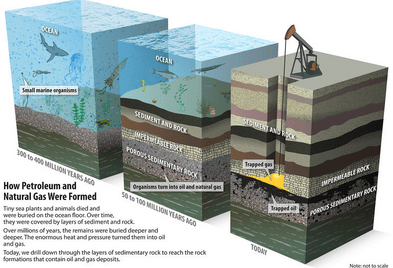Picture this: deep beneath the Earth’s surface, where darkness reigns and unimaginable pressures play, an intricate alchemical dance unfolds, giving birth to the black gold that fuels our modern world—petroleum. Its formation, spanning millions of years, is a captivating testament to nature’s transformative powers. Let us embark on a journey to understand the fascinating process that brings this liquid treasure to our doorstep.

Image: www.valuethemarkets.com
From Ancient Seas to Buried Treasures
Petroleum’s tale begins in the depths of ancient oceans, where microscopic marine organisms, such as plankton and algae, thrived in abundance. As these tiny creatures passed from life into eternity, their remains sank to the ocean floor, forming thick layers of organic matter. Over time, these layers became covered by sediments—sand, silt, and clay—as the ocean’s ebbs and flows buried the organic material under increasing pressure and temperature.
This subterranean pressure transformed the organic matter into a substance known as kerogen, a complex mixture of hydrocarbon molecules still found in petroleum-bearing rock formations. However, these immense temperatures and pressures have a further transformative effect, cooking the kerogen into liquid petroleum. This process, aptly known as thermal cracking, is like the Earth’s subterranean distillery, carefully crafting the fuel that drives much of our industries and societies.
But the journey doesn’t end there. The newly formed liquid petroleum embarks on a meandering path through the porous rock formations underground. Along this subterranean labyrinth, it separates from water and other impurities, evolving into the oil we know.
The Quest for Petroleum’s Ancestral Home
Identifying where this liquid treasure lies is no easy feat. Geologists employ advanced techniques like seismic surveys to study the Earth’s subsurface structure, hunting for those areas where conditions were just right for petroleum formation. These surveys send sound waves into the ground, revealing subtle changes in rock density and structure that hint at potential petroleum reservoirs.
Exploration and drilling are the final chapters in this captivating saga. Once a promising location is identified, explorers cautiously drill through thousands of meters of rock, hoping to strike liquid petroleum. When the drill bit finally penetrates the reservoir, a rush of black gold can bring a sense of triumph and the promise of powering countless engines for years to come.
The Value of Petroleum: A Double-Edged Sword
Petroleum has revolutionized our lives, fueling transportation, powering industries, generating electricity, and forming the basis of countless products we use daily. Yet, its extraction comes at a price, both environmentally and economically. Its combustion releases greenhouse gases and pollutants into the atmosphere, contributing to climate change and air quality concerns. Moreover, its extraction can be a hazardous undertaking. Spills have devastating impacts on wildlife, pollute water sources, and can even threaten human health.

Image: ar.inspiredpencil.com
Explain The Process Of Formation Of Petroleum
Seeking a Sustainable Path Forward
As we face the challenges of climate change and global energy needs, it is imperative to find sustainable ways to utilize petroleum while minimizing its environmental impacts. Transitioning to renewable energy sources, such as solar and wind power, is paramount for a cleaner future. Simultaneously, improving extraction efficiency and implementing stringent environmental regulations are crucial steps towards ensuring petroleum’s benefits outweigh its drawbacks.
In the meantime, let us never forget the remarkable journey that brings petroleum to our pumps—a testament to the Earth’s profound transformative powers and its immense significance to humankind.